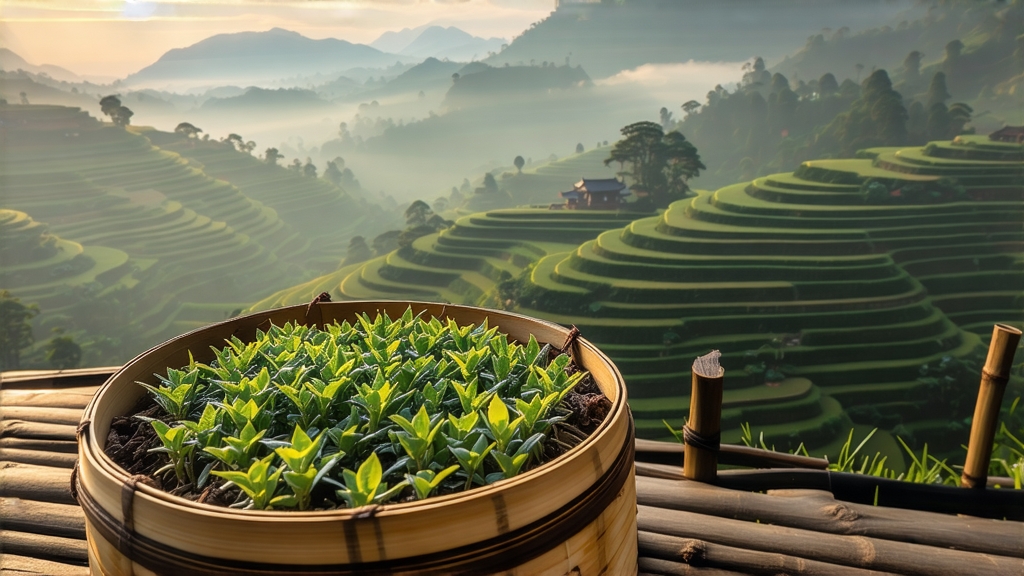
Tucked high on the mist-lapped slopes of Mt. Meng in Sichuan Province, a tea once reserved for Tang-dynasty emperors still unfurls its velvet buds each early April. International drinkers may speak freely of Longjing or Pu-erh, yet few have tasted Meng Ding Huang Ya, the “Yellow Bud from the Summit of Meng.” This essay invites the curious palate on a complete journey—from Han-dynasty legend to twenty-first-century cup—through China’s most discreet yellow tea.
-
A leaf born of myth and mountain
Local gazetteers insist that the Daoist monk Wu Lizhen planted the first seven tea bushes on Meng Ding’s summit in 53 BCE, rendering the mountain arguably the oldest documented tea garden on earth. By the Tang era (618-907 CE) the tender buds, wrapped in silk and escorted by fast horses, reached Chang’an within five days to satisfy an imperial court newly enamored of “sweet dew from the clouds.” The Song continued the habit, and Ming scholars canonized the tea in the “Complete Compendium of Tea,” praising its “jade-yellow liquor born between stone and cloud.” Only after the 1950s, when state tea institutes revived traditional yellowing techniques, did Meng Ding Huang Ya re-emerge from dynastic memory into limited global commerce. -
What makes a tea “yellow”?
All Chinese yellow teas share one defining craft stage—sealed yellowing (men huang)—where the leaf is lightly heated, piled in small heaps, and wrapped in thick cloth or paper for four to seven days. During this micro-fermentation chlorophyll degrades, polyphenols oxidize slightly, and a fresh hay or lotus aroma develops while astringency ebbs. The result is a liquor gentler than green tea yet brighter than white, often described as “warm dawn in a glass.” Meng Ding Huang Ya is the archetype: tiny single buds, plucked before Qingming when mountain nights still dip to 8 °C, carry so little tannin that even three-minute infusions remain silk-smooth. -
Micro-terroir of the summit
Mt. Meng rises 1 450 m where the Sichuan basin meets the Tibetan plateau. Morning clouds act as a natural shade cloth, filtering UV and slowing photosynthesis; the leaf therefore stockpiles theanine, the amino acid behind savory sweetness. Granitic soils, rich in potassium yet low in fluoride, force roots to struggle, concentrating aromatic volatiles. Finally, temperature swings of 15 °C between day and night lock in floral precursors—linalool and geraniol—that later surface as orchid and honey notes in the cup. -
Crafting the bud: a 72-hour choreography
Day 1, 04:30 – Plucking: only the “sparrow’s tongue” bud—unopened, 15–20 mm, covered in down—is snapped sideways to keep the growth point intact.
06:00 – Withering: buds are spread one layer deep on bamboo trays set inside a shaded pavilion; mountain breeze reduces moisture from 76 % to 68 % within three hours.
10:00 – First firing: hand-tossed for three minutes in woks held at 130 °C; the kill-green arrests enzymatic oxidation yet keeps 8–10 % internal water.
13:00 – Rolling: the warm buds are rolled for eight minutes under 3 kg of pressure, just enough to fracture cell walls without breaking the tip.
15:00 – Wrapping: 250 g portions are wrapped in mulberry paper, then in steamed cloth, forming tight 10 cm “bundles.”
Day 2–3 – Yellowing: bundles rest inside a pine-wood cabinet at 28 °C and 75 % RH; every eight hours the master opens, fluffs, and re-wraps the leaf to ensure even respiration. A faint yellow tint appears, accompanied by the scent of fresh corn silk.
Day 4 – Second firing: wok temperature is lowered to 80 °C; the now-pliant buds are dried to 20 % moisture.
Day 5 – Final baking: charcoal embers at 50 °C finish the leaf for four hours while artisans repeatedly sift and shake; finished buds contain 5 % moisture and snap cleanly.
Throughout, the leaf never leaves the mountain; altitude and low oxygen slow every reaction, gifting the tea its signature cool-sweet finish.
- Grades and nomenclature
Modern Meng Ding Huang Ya